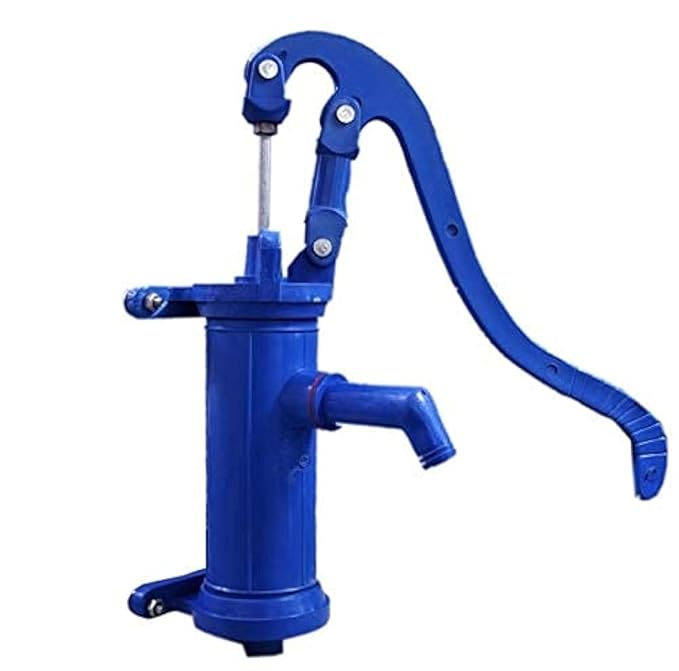
How Did Ancient People Collect Water Without Electricity or Pipes?
Have you ever wondered how people got water before taps, pipelines, or electricity existed? Today, if we’re thirsty, we simply turn a handle and clean water flows out. But thousands of years ago, things were very different. Water had to be collected manually — every single day. For ancient people, water was not just a necessity; it was a challenge that required creativity, teamwork, and clever engineering.
Interestingly, long before modern motors and machines, humans invented brilliant tools to lift, move, store, and purify water. Many of these old techniques are so efficient that they are still used in some parts of the world today. In this blog, we’ll explore how our ancestors collected water and the smart inventions they developed to make life easier.
To explore all of these processes in 3D, check out our detailed YouTube explanation linked at the end of this blog — and don’t forget to subscribe for more insightful videos! (Available in English & Malayalam )

Love what I do?
Consider supporting my work by👉 buying me a coffee
Why Water Collection Was So Important in Ancient Times?
Before reading about each invention, it helps to understand why ancient people put so much effort into developing water-lifting systems:
1. Rivers Were Not Always Nearby
Civilizations grew near rivers, but people working in farms or living on higher ground still needed a way to bring water to their homes and crops.
2. Water Was Needed Every Day
Drinking, cooking, bathing, farming, making clay, washing clothes, feeding animals — everything depended on water.
3. Rainfall Was Unpredictable
In many places, like Egypt, Iran, and India, rainfall could be seasonal or scarce. Collecting and storing water was essential for survival.
4. Manual Lifting Was Hard
Lifting water from deep wells or steep riverbanks takes strength. Tools were needed to reduce physical effort.
Because of these challenges, people developed simple machines using wood, stone, rope, clay, and human or animal power. Let’s look at some of the most fascinating inventions.
The Shadoof – A 4000-Year-Old Invention
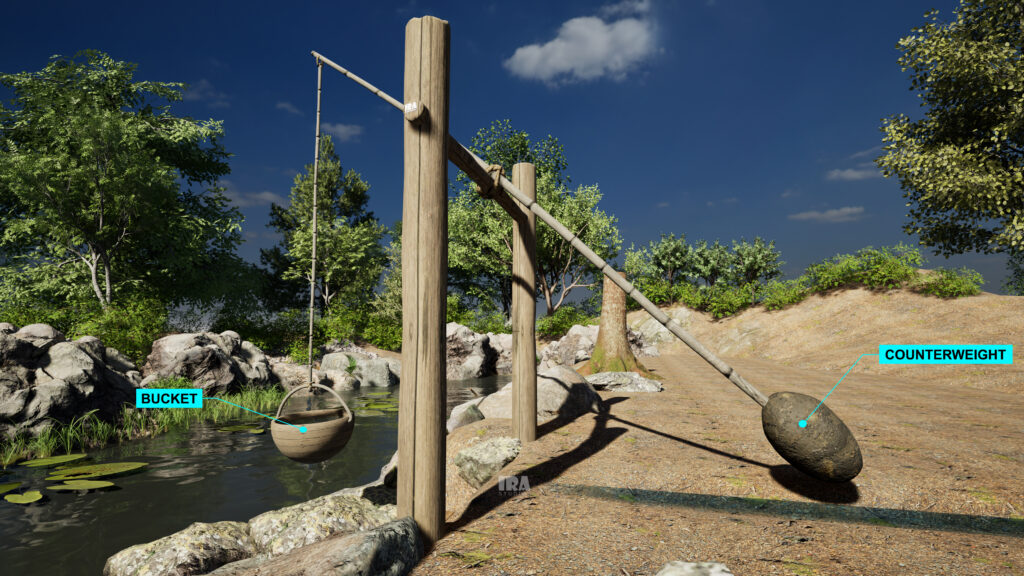
One of the earliest water-lifting devices ever invented is the Shadoof (also spelled shaduf). It originated in ancient Egypt around 2000 BC, though it spread to the Middle East and India later.
How the Shadoof Worked
Although simple, the Shadoof was extremely efficient. It followed the principle of the lever, a basic machine still studied today.
A Shadoof had:
A long wooden beam (like a seesaw)
A bucket or pot at one end to scoop water
A counterweight (stone, clay, or mud) at the other end
A vertical pole acting as the pivot
When a person pulled the bucket down into the river or well, the counterweight helped pull it back up easily. Even children or elderly people could operate it because most of the work was done by the counterweight.
Where Shadoofs Were Used
Egypt: To irrigate farms along the Nile
India: Especially in villages with riverbanks or ponds
Mesopotamia: For irrigation and small-scale farming
Multi-Level Shadoofs
In areas with very steep banks, people built a chain of Shadoofs at different levels. Water was passed from one level to another until it reached the top. This was an early example of a multi-stage lifting system, showing how intelligently people used simple tools.
Why the Shadoof Is Still Admired
Uses no electricity
Requires very little strength
Easy to repair
Made from natural materials
Even today, tourists visiting Egypt can still see Shadoofs being demonstrated near the Nile.

Multi-level Shadoofs
Want to dive deeper into how a Shadoof works? Explore our full blog post packed with visuals and clear explanations.👇
Shadoof-The Ancient Water-Lifting Tool That Changed Farming Forever
The Persian Wheel – A Turning Point in Water Technology
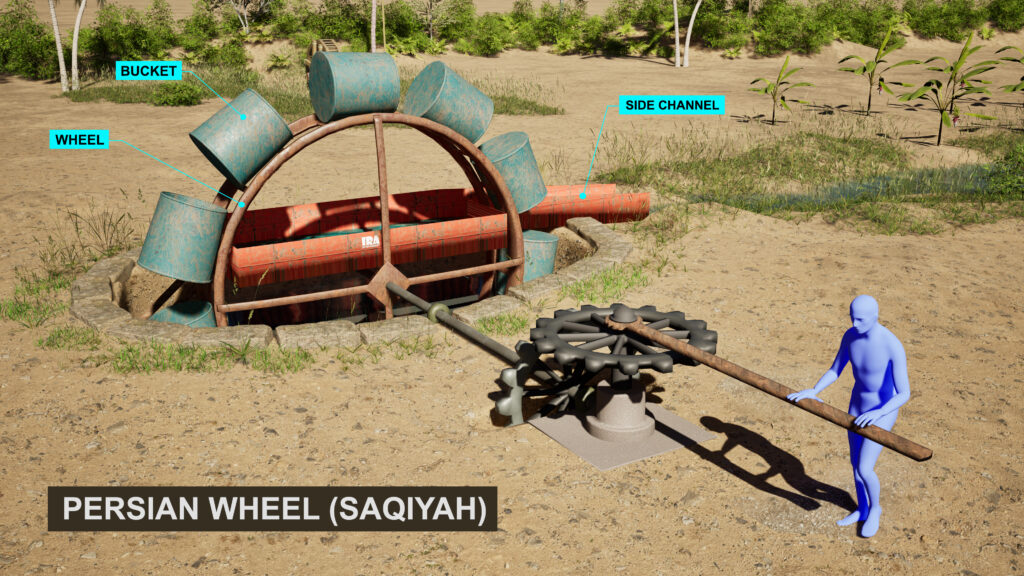
Around 500 BC, in ancient Persia and India, another remarkable water-lifting device emerged: the Persian Wheel, or Saqiyah.
Unlike the manual Shadoof, the Persian Wheel was mechanized using human or animal power. Here’s how it worked:
A large vertical wheel was installed above a well or water source
Attached to the wheel were buckets or earthen pots at equal distances
As the wheel rotated, the buckets dipped into the water, filled up, and were lifted to the top
Water was poured into a trough and carried to farms or storage tanks
Initially, the wheel was turned by hand, but later it was powered by bulls, camels, or donkeys. This innovation allowed people to draw large amounts of water without much human effort, making it perfect for irrigation in dry regions.
The Persian Wheel remained in use for centuries and is still seen in parts of rural India and Pakistan today.Around 500 BC, another impressive invention appeared: the Persian Wheel, also called the Saqiyah or Sakia. This device was far more advanced than the Shadoof because it used continuous rotation and could lift much larger volumes of water.
How the Persian Wheel Operated
The system consisted of:
A large vertical wheel
Several pots or buckets attached along the rim
A horizontal gear wheel connected to animal power
A trough to collect and transport water
Animals like bulls, camels, buffaloes, or donkeys walked in circles to rotate the wheel. As the wheel turned:
Buckets dipped into the water source
Filled up naturally
Rose to the top
Emptied into a channel
Carried water to fields, tanks, or storage units
Where the Persian Wheel Was Popular
Persia (Iran) — where it originated
India, especially Uttar Pradesh, Rajasthan, and Punjab
Pakistan, particularly in rural farming regions
Egypt and Syria
Why the Persian Wheel Was a Game-Changer
Could lift water continuously
Required very little human effort
Could irrigate large farms
Worked in both shallow and deep wells
In many Indian villages, Persian Wheels remained common until the mid-20th century, and you can still find some working examples today.

Want to dive deeper into how a Persian Wheel works? Explore our full blog post packed with visuals and clear explanations.👇
Persian Wheel (Saqiyah): The Ancient Water Lifting Machine That Turned Deserts Into Farmland
Other Ancient Water-Lifting Techniques
While the Shadoof and Persian Wheel are famous, many other cultures invented equally clever systems. Here are some notable ones.
1. The Archimedes’ Screw
Invented by the Greek scientist Archimedes around 250 BC, this device could lift water by rotating a screw-shaped tube.
How it Worked
As the screw turned (by hand or animal power), water moved upward through the spiral tube and poured out at the top.
Where It Was Used
Egypt for irrigation
Greece for removing water from ships
Later in Europe for draining marshes
It was efficient, simple, and could lift water to greater heights than the Shadoof.
2. The Qanat System – Underground Water Tunnels
In ancient Persia, people invented qanats — long underground tunnels that carried groundwater from mountains to villages.
Advantages
Kept water cool under the ground
Reduced evaporation in hot climates
Could carry water for kilometers
Qanats are still in use in Iran, Afghanistan, and parts of India (where they are called karez).
3. The Stepwell – India’s Architectural Wonder
Stepwells, or baolis, were beautifully engineered structures where steps led deep down to the water table.
Why Stepwells Were Unique
Served as water sources
Provided cool resting places
Acted as social and cultural centers
Some famous stepwells in Gujarat and Rajasthan are over 1,000 years old and still functional.
Rainwater Harvesting – A Timeless Method
Collecting rainwater is as ancient as human civilization itself. People used:
Clay pots
Rooftop channels
Stone tanks
Underground cisterns
In India, structures like Johads, Tanka, Eris, and Kunds collected rainwater for drinking and farming.
Rainwater harvesting required no machines — just smart planning.
The Hand Pump – A Leap into the Metal Age
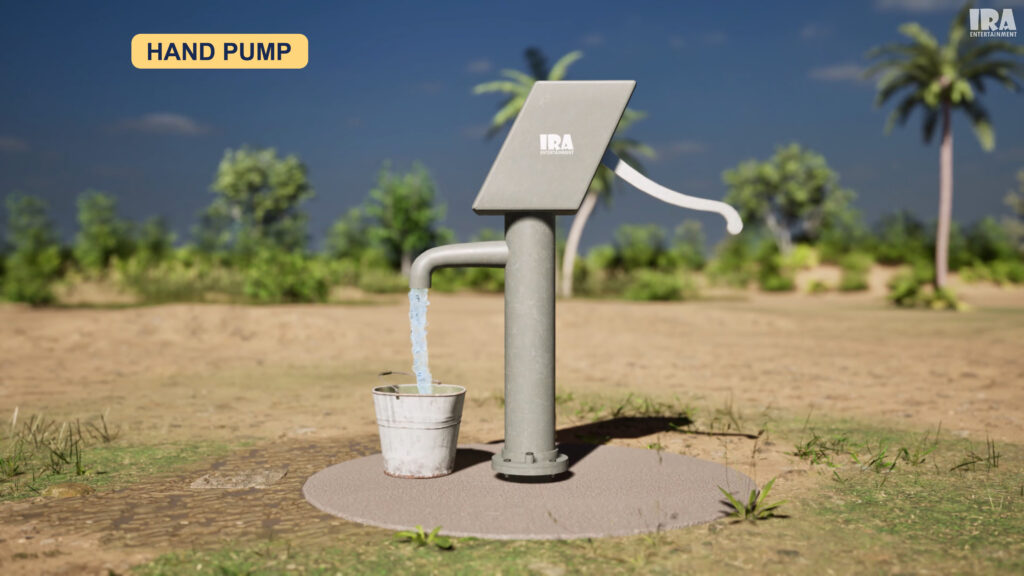
By the 1800s, iron and steel production improved, leading to the invention of the hand pump. Unlike earlier wooden devices, hand pumps were durable and could reach much deeper groundwater.
How Does a Hand Pump Work?
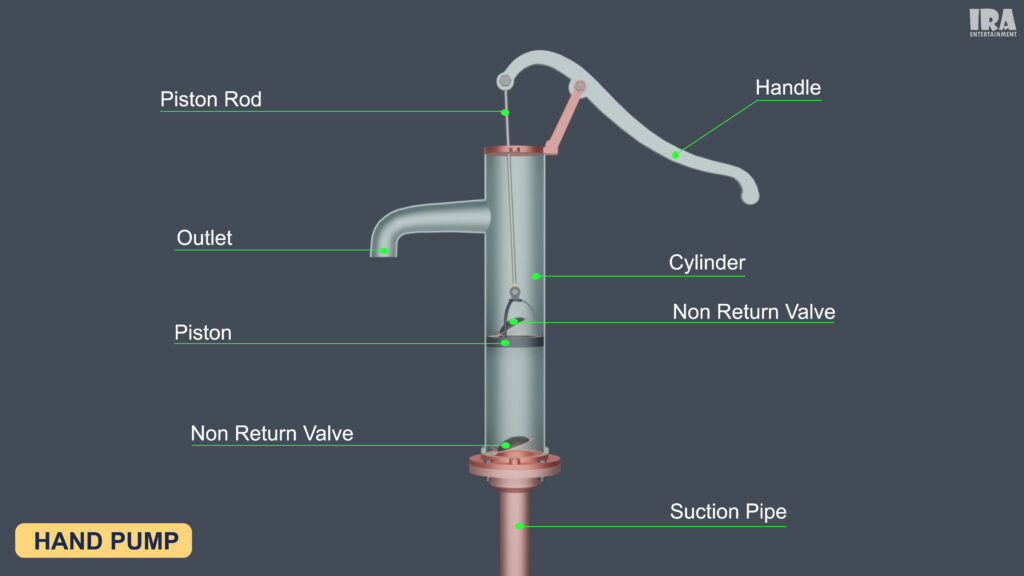
How a Hand Pump Works
A typical hand pump has:
A cylinder above the water level
A handle connected to a piston rod
A piston with a non-return valve
A foot valve at the bottom
A pipe going deep into the well
An outlet for water
When the handle is moved up and down:
A vacuum forms
Water is sucked up into the cylinder
It moves upward and flows through the outlet
Why Hand Pumps Became Popular
Strong and long-lasting
Could access deeper aquifers
Easy to operate
Required no external power
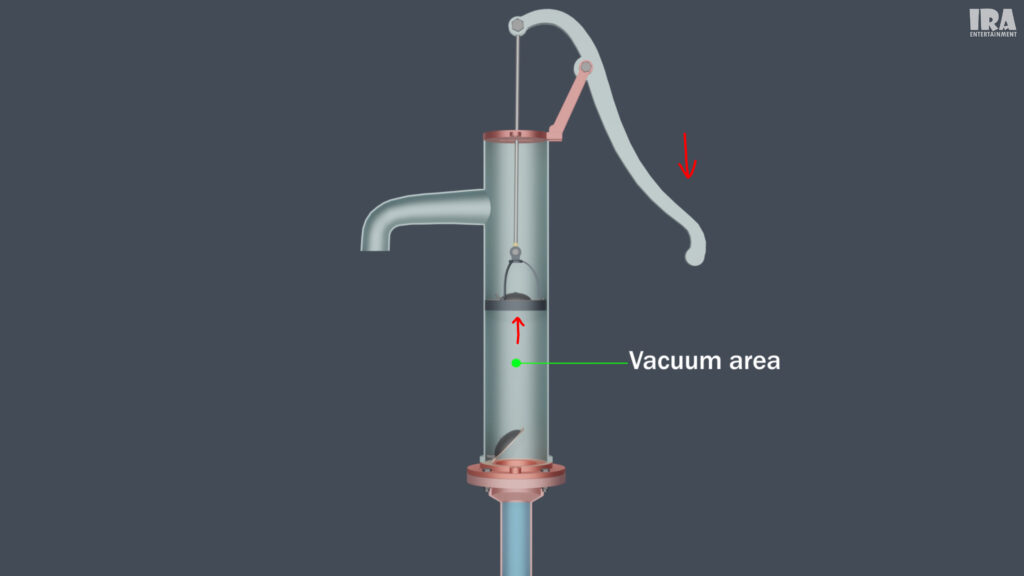
This up-and-down motion makes it easy to draw water, even from deep underground sources. Hand pumps became popular worldwide and are still used in many places today.

Want to dive deeper into how a hand pump works? Explore our full blog post packed with visuals and clear explanations.👇
How Ancient Techniques Influence Modern Water Management
Modern water technology may look advanced — electric pumps, pipelines, filtration plants — but the principles behind them are ancient.
The Shadoof Inspired:
Modern manual lever systems
Counterweight-operated tools
The Persian Wheel Inspired:
Water wheels used in mills
Continuous-loop irrigation systems
Qanats Inspired:
Modern underground drainage
Tunnel-based water supply systems
Stepwells Inspired:
Sustainable architecture practices
Water conservation structures
Hand Pumps Inspired:
Modern borewell pumps
Manual suction systems
These inventions show that engineering doesn’t always need to be co

Life Lessons from Ancient Water Systems
Ancient people faced problems we still face today:
Water scarcity
Uneven rainfall
Energy limitations
Environmental challenges
But they used creativity instead of relying on expensive technology.
From their solutions, we learn:
Sustainability works
Simple machines can solve big problems
Nature-based solutions are long-lasting
Low-cost ideas can help millions
In many developing regions, traditional devices continue to be lifelines, especially where electricity is unreliable.
Conclusion
The story of water collection across history is a story of human intelligence and survival. From the simple wooden Shadoof to the rotating Persian Wheel, from underground qanats to modern hand pumps, every invention reflects how people adapted to their environment with creativity and determination.
Even today, engineers look back at these ancient devices for inspiration — because sustainable ideas never go out of style.
Water is essential for life, and so is innovation. Our ancestors proved that you don’t always need modern machines to solve big problems — just observation, creativity, and clever design.
Related Amazon Products (Affiliate link )
Plastic PVC Hand Pump for Home, Garden
Want to learn more through visual storytelling? Check out our detailed 3D explanation blog on Treadwheel Crane: Ancient Engineering Marvel Explained with 3D Visuals
Useful Link – Wikipedia
Check out our related products and other links 👉 Products & other platforms
